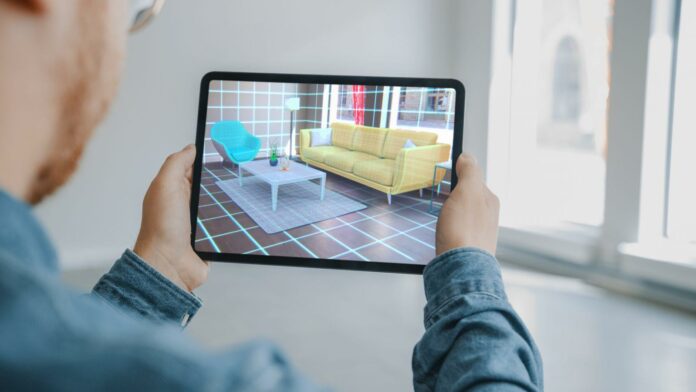In the heart of Australia’s bustling furniture industry, a digital revolution is underway, one that promises to transform the way we design and experience our homes. Augmented Reality (AR) technology has surfaced as a revolutionary influence, reshaping the conventional confines of interior design and the furniture shopping journey. As more and more consumers seek personalised, innovative, and convenient solutions, AR in furniture has become a game-changer, offering a seamless blend of the physical and digital worlds.
Australia’s furniture market, known for its diverse and ever-evolving design aesthetics, is the perfect backdrop for the integration of AR. This technology enables customers to conveniently browse a wide range of furniture products from the comfort of their own homes, eliminating the necessity for time-consuming trips to physical retail outlets. AR in furniture design also enables customers to visualise how a piece will fit into their existing decor, providing a level of confidence and satisfaction previously unimaginable. In this article, we will delve into the exciting landscape of Augmented Reality in the Australian furniture industry.
Definition of Augmented Reality (AR)
Augmented Reality (AR) refers to a technology that superimposes computer-generated digital elements, such as images, videos, or 3D models, onto the physical world. By using AR-enabled devices like smartphones, tablets, or specialised AR glasses, users can experience an enhanced version of reality, where virtual objects seamlessly blend with their physical surroundings. AR technology has rapidly evolved and found applications in various industries, and its significance in the furniture industry, particularly in Australia, cannot be understated.
The Traditional Furniture Shopping Experience
The Traditional Furniture Shopping Experience in Australia offers consumers various avenues to explore and purchase furniture, including brick-and-mortar stores and online shopping. Each option comes with its own set of advantages and limitations, providing shoppers with a diverse array of choices.
Brick-and-Mortar Stores:
Brick-and-mortar furniture stores are a staple of the traditional shopping experience in Australia. Customers can physically interact with the furniture, sit on sofas, inspect wood grains, and assess quality firsthand. The in-store experience allows for personalised assistance from knowledgeable sales staff, who can provide valuable insights and help customers make informed decisions. Additionally, shoppers can take immediate delivery of their purchases, avoiding shipping times and costs.
Online Shopping:
Online furniture shopping has gained popularity due to its convenience and accessibility. Shoppers can explore a vast selection of products from the comfort of their homes, with the option to compare prices, read reviews, and research extensively. Numerous e-commerce platforms provide comprehensive product descriptions, top-notch visuals, and feedback from customers, all aimed at assisting shoppers in making well-informed decisions. Online shopping also provides the convenience of doorstep delivery, making it an attractive option for those who prefer not to visit physical stores.
Limitations and Challenges:
While both brick-and-mortar stores and online shopping have their merits, they also come with limitations and challenges. Brick-and-mortar stores may have higher overhead costs, which can result in higher furniture prices. In contrast, online shopping may lack the tactile experience and personal assistance provided by in-store staff. Customers also face challenges like shipping delays, potential damage during delivery, and the hassle of returning items purchased online.
Moreover, the absence of seeing the furniture in person may lead to discrepancies in colour, texture, and size. Customers need to rely on online product descriptions and images, which may not always accurately represent the actual product.
Benefits of AR in Furniture Shopping
Augmented Reality has transformed the furniture shopping landscape in Australia, providing a multitude of advantages that elevate the entire shopping journey. AR in furniture shopping has gained momentum due to its immersive and interactive nature, making it a game-changer for both consumers and retailers.
1. Visualising Products: AR allows customers to visualise how a piece of furniture will look in their home. By simply pointing their smartphone or tablet at an empty space, they can superimpose virtual furniture into their real-world environment. This helps in making informed decisions, reducing the likelihood of mismatched purchases.
2. Interactive Catalogues: Retailers can develop AR applications that provide interactive Catalogues, allowing customers to explore their entire inventory from the comfort of their homes. This increases customer engagement and helps them discover a broader range of products.
3. Customisation: AR technology enables customers to customise furniture by changing colours, materials, and dimensions. This level of personalisation ensures that the chosen piece of furniture aligns perfectly with their interior design, thereby reducing the chances of dissatisfaction.
4. Reduced Returns: With the ability to “try before you buy” virtually, AR minimises the need for returns, saving both customers and retailers time and resources. This results in a more efficient and sustainable shopping process.
5. Enhanced Shopping Experience: AR elevates the shopping experience, making it more enjoyable and memorable. Customers are not limited to static images; they can interact with furniture, zoom in, and get a closer look at intricate details.
6. Market Differentiation: For furniture retailers, embracing AR development and its applications can set them apart from competitors, attracting tech-savvy customers who appreciate the convenience and innovation.
As technology continues to evolve, AR is poised to become an integral part of the furniture retail industry, creating a win-win situation for both consumers and businesses.
Augmented Reality in Furniture Shopping: Practical Application
In this article, we will explore how AR apps work, provide examples of furniture retailers using AR, and share customer success stories.
How AR Apps Work:
AR apps enhance the furniture shopping experience by overlaying digital 3D models of furniture onto the real world, typically through a smartphone or tablet. Here’s how it works:
· Camera Integration: AR apps utilise the device’s camera to capture the real environment and integrate virtual furniture pieces seamlessly.
· 3D Rendering: The app renders detailed 3D models of furniture, which users can place, move, and interact with in their real space.
· Real-Time Adjustments: Users can adjust the colour, size, and style of the virtual furniture to match their preferences.
· Visualisation: AR apps empower customers to envision how the furniture will appear and fit within their living spaces, providing a more precise depiction of their prospective purchase.
Examples of Furniture Retailers Using AR:
Several furniture retailers in Australia have adopted AR technology to provide a more immersive shopping experience. Some notable examples include:
· IKEA: The global giant offers the IKEA Place app, allowing customers to virtually place their furniture in their homes to gauge suitability and style.
· Amart Furniture: This Australian retailer uses AR to help customers visualise how their furniture will fit into different room settings.
· Koala: Known for its eco-friendly furniture, Koala’s app offers AR to help customers see their products in their living spaces before making a purchase.
Customer Success Stories:
The implementation of AR in furniture shopping has yielded numerous success stories:
1. Enhanced Decision-Making:
Customers appreciate the ability to virtually test out furniture in their homes, which minimises buyer’s remorse. This enhanced decision-making process has led to higher customer satisfaction and fewer returns for retailers.
2. Increased Sales:
By offering AR experiences, retailers have seen an uptick in sales. Shoppers are more confident in their choices, resulting in higher conversion rates and increased revenue. Additionally, AR encourages customers to explore more products, potentially leading to larger orders.
Challenges and Considerations
Augmented Reality (AR) has revolutionised various industries, and the furniture sector in Australia is no exception. AR in the furniture industry offers exciting opportunities for both retailers and consumers. However, it comes with its set of challenges and considerations.
- Integration and Development Costs: Implementing AR technology can be expensive, as it requires specialised software and hardware. Businesses need to invest in the development of AR applications and ensure their seamless integration into their existing systems.
- User Experience: Creating an engaging and user-friendly AR app is essential. If the app is not intuitive or the AR experience is subpar, customers may lose interest. User experience must be a top priority for furniture companies.
- Hardware Compatibility: Ensuring the compatibility of AR apps with a diverse range of devices and operating systems can pose a significant challenge. Companies need to consider the wide range of smartphones and tablets used by their customers.
- Data Privacy and Security: Collecting customer data through AR apps raises privacy concerns. Companies must be diligent in protecting user information and complying with Australian data protection regulations.
- Content Quality: The success of AR in the furniture industry relies heavily on the quality of 3D models and the realism of AR representations. Creating and maintaining a database of high-quality 3D models can be a significant challenge.
- Customer Education: Many consumers may not be familiar with AR technology or how to use AR apps for furniture shopping. Companies must invest in educating their customers to maximise the technology’s potential.
- Connectivity and Speed: Reliable internet connectivity is crucial for a smooth AR experience. In some parts of Australia, where internet speeds may vary, this can be a limitation.
- Showroom Experience: Retailers with physical stores face the challenge of blending the online and in-store experiences. Customers expect consistency between the AR experience and what they find in physical showrooms.
- Return Policies and Customer Satisfaction: If the AR representation does not match the real-life product, it can lead to dissatisfaction and product returns. Companies must have clear return policies in place to handle such scenarios.
- Competitive Advantage: As AR becomes more common in the furniture industry, staying ahead of the competition can be a challenge. Businesses should persist in their innovation efforts and provide distinctive augmented reality (AR) experiences to set themselves apart.
How to Get Started with AR Furniture Shopping
Furniture shopping has evolved with the introduction of Augmented Reality (AR) technology, offering a convenient and immersive experience. To get started with AR furniture shopping in Australia, follow these steps:
Downloading AR Apps:
- Search for AR furniture shopping apps in your device’s app store. Popular options include IKEA Place, Zeal AR, and Wayfair.
- Choose and install the app that aligns with your preferences. Ensure your device is AR-compatible, typically requiring iOS 11 or later for Apple devices and Android 7.0 or newer for Android devices.
Tips for a Successful AR Furniture Shopping Experience:
- Prepare your space: Before using the AR app, clear the area where you plan to place the furniture. This allows for a more accurate Visualisation of how the furniture will fit.
- Measure accurately: Take precise measurements of your room, including doorways and other potential obstacles, to ensure the furniture will fit comfortably.
- Experiment with styles: Try various furniture styles and colours using the app to see what complements your decor and preferences.
- Seek reviews and recommendations: utilise online resources to read reviews, ask for recommendations, or browse through customer feedback on specific AR solutions in Australia.
Online Resources and Tutorials:
- Browse furniture stores’ websites: Many furniture retailers offer AR solutions, and their websites often provide tutorials on how to use their AR apps effectively.
- Watch video tutorials: Search for online tutorials that guide you through the AR shopping process, giving you helpful tips and tricks.
- Join online forums and communities: Engage with fellow AR furniture shoppers to share experiences, ask questions, and gain insights on the best AR service for your needs.
By following these steps and utilising the vast AR resources available, you can make your furniture shopping in Australia a seamless and enjoyable experience, all from the comfort of your home. Augmented Reality apps have revolutionised the way we envision and select furniture, making the process more convenient and efficient.
In conclusion, the integration of augmented reality (AR) technology into the furniture industry has undeniably revolutionised home design in Australia. AR furniture apps have empowered consumers to visualise, customise, and virtually place furniture items within their living spaces, providing an unparallelled level of convenience and confidence in purchasing decisions.
As the demand for AR in home design continues to grow, it has also paved the way for Australian businesses to thrive. The best augmented reality companies in the region have leveraged this technology to create innovative and user-friendly applications, enhancing the shopping experience and making it more interactive and engaging.
With AR, consumers can make informed choices, reduce the likelihood of costly mismatches, and ultimately create spaces that better reflect their personal style and functional needs. The marriage of technology and design in Australia’s furniture industry promises to be a trend that will persist and evolve, offering boundless possibilities for the future of home interior design.









